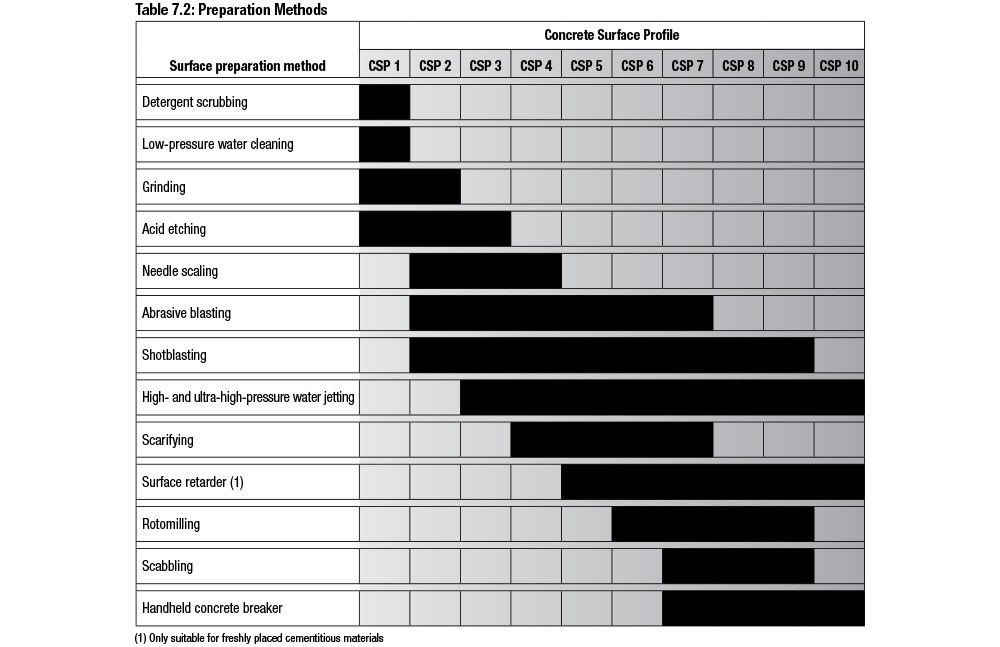Many contractors use fast-setting cementitious repair materials to finish the job faster – and get paid faster. Experience, especially mistakes, is the best teacher. But troubleshooting takes time and money, two things no contractor wants to waste.
Fortunately, the principles for successfully using standard cementitious repair materials apply to fast-setting cements as well, so you don’t have to learn anything new. Also fortunately, there’s the International Concrete Repair Institute (ICRI).
ICRI’s “Selecting and Specifying Concrete Surface Preparation for Sealers, Coatings, Polymer Overlays, and Concrete Repair” (Technical Guideline No. 310.2R-2013) addresses virtually all aspects of any repair and restoration project, including floors.
I suggest familiarizing yourself with these technical guidelines because they’re industry-accepted best practices. Why reinvent the wheel if you don’t have to?!
No. 1. Follow The Manufacturer’s Directions. It Really Is That Simple.
Manufacturers don’t provide directions for the fun of it. They want you to successfully use their product, which may require particular methods, processes, and/or tools.
This is especially true for rapid-setting cementitious repair materials. I can’t tell you how many times after training a contractor’s crew I’m called about a failure because they did something different on the jobsite.
Do yourself and your client a favor: Avoid expensive rework by reading and following the directions.
No. 2. Surface Preparation: Skip At Your Own Risk.
This is the least expensive and most important step to ensure a repair or overlay lasts. Your goal is to apply the repair material to clean, structurally sound substrate.
Abrading the surface opens the pores in the existing concrete, which allows water to enter, which kicks off the process of adhering to the repair material’s cementitious content. That’s why vacuuming before wetting the surface is so important – you don’t want dust and debris to impede the bonding process.
Every cementitious repair material manufacturer provides guidance on how and to what extent to texture the substrate surface before applying their product. This usually includes a reference to ICRI concrete surface profile (CSP). CSP ranges from 1 to 10, with 1 being the smoothest and 10 being the roughest surface texture.
Here again, follow the manufacturer’s directions. Fast-setting cementitious repair products can be made with portland, calcium sulfoaluminate (CSA), or calcium aluminate (CA) cement. Each is a different chemistry with different requirements.
For example, acid etching is an ICRI-approved surface profiling method, but we don’t recommend it for our LevelFlor® underlayment or TRU® self-leveling polishable toppings. Similarly, ICRI recommends CSP 4 – 6 for self-leveling toppings, but we recommend CSP 3 – 5 for ours.
One more thing. After decades repairing concrete, I consider surface porosity as important as surface texture. A CSP 10 that’s smooth won’t bond as well to new cementitious material as a CSP 1 that’s porous. To test porosity, spray water on the surface and see how quickly it absorbs. The faster it absorbs, the more porous the surface. You want it to absorb instantly.
 Table 7.2: Preparation_Methods. Source: International Concrete Repair Institute, “Selecting and Specifying Concrete Surface Preparation for Sealers, Coatings, Polymer Overlays, and Concrete Repair” (Guideline No. 310.2R-2013)
Table 7.2: Preparation_Methods. Source: International Concrete Repair Institute, “Selecting and Specifying Concrete Surface Preparation for Sealers, Coatings, Polymer Overlays, and Concrete Repair” (Guideline No. 310.2R-2013)
No. 3. Do NOT Retemper! If You Stage The Job Correctly, You Won’t Be Tempted To.
By definition, rapid-setting cementitious products provide less working time. Hot substrate draws water out of cement, causing rapid-setting material to set even faster – which gives you even less working time. This is why I urge crews to store bagged cement products in the shade whenever possible.
Stage the job as you usually do, but devise a Plan B for anything and everything that could go wrong before mixing. Every second counts, so you don’t want to waste time searching for material, water, admixtures, tools, equipment, and crew members.
Many flooring contractors, for example, have one crew mix and pour an underlayment or overlay while another follows with a gauge rake or broom to finish.
You’ll be tempted to add water if the mix starts stiffening before you’re finished. Don’t do it. Changing the water-to-cement ratio lowers strength. It changes how the product works, finishes, and cures. The material usually dries lighter.
To give yourself more time:
Don’t store material in direct sunlight or hot rooms. Hot material kicks off faster.
Use chilled water as mix water.
Add the manufacturer’s recommended amount of SET Control® to the mix.